Yuxuan Xia
HilbertA: Hilbert Attention for Image Generation with Diffusion Models
Sep 30, 2025



Abstract:Designing sparse attention for diffusion transformers requires reconciling two-dimensional spatial locality with GPU efficiency, a trade-off that current methods struggle to achieve. Existing approaches enforce two-dimensional spatial locality but often incur uncoalesced memory access. We present HilbertA, a 2D-aware and GPU-efficient sparse attention mechanism. HilbertA reorders image tokens along Hilbert curves to achieve a contiguous memory layout while preserving spatial neighborhoods, and employs a sliding schedule across layers to enable long-range information propagation without repeated or uncoalesced memory access. To further enhance cross-tile communication and positional awareness, HilbertA introduces a small central shared region. Implemented in Triton, HilbertA delivers comparable image quality with significant acceleration over prior methods on Flux.1-dev, demonstrating the feasibility of hardware-aligned two-dimensional sparse attention for high-resolution image generation. HilbertA delivers attention speedups of $2.3\times$ when generating $1024\times 1024$ images, and up to $4.17\times$ at $2048\times 2048$, while achieving image quality comparable to or surpassing baselines.
Probabilistic Trajectory GOSPA: A Metric for Uncertainty-Aware Multi-Object Tracking Performance Evaluation
Jun 18, 2025Abstract:This paper presents a generalization of the trajectory general optimal sub-pattern assignment (GOSPA) metric for evaluating multi-object tracking algorithms that provide trajectory estimates with track-level uncertainties. This metric builds on the recently introduced probabilistic GOSPA metric to account for both the existence and state estimation uncertainties of individual object states. Similar to trajectory GOSPA (TGOSPA), it can be formulated as a multidimensional assignment problem, and its linear programming relaxation--also a valid metric--is computable in polynomial time. Additionally, this metric retains the interpretability of TGOSPA, and we show that its decomposition yields intuitive costs terms associated to expected localization error and existence probability mismatch error for properly detected objects, expected missed and false detection error, and track switch error. The effectiveness of the proposed metric is demonstrated through a simulation study.
The ML.ENERGY Benchmark: Toward Automated Inference Energy Measurement and Optimization
May 09, 2025Abstract:As the adoption of Generative AI in real-world services grow explosively, energy has emerged as a critical bottleneck resource. However, energy remains a metric that is often overlooked, under-explored, or poorly understood in the context of building ML systems. We present the ML.ENERGY Benchmark, a benchmark suite and tool for measuring inference energy consumption under realistic service environments, and the corresponding ML.ENERGY Leaderboard, which have served as a valuable resource for those hoping to understand and optimize the energy consumption of their generative AI services. In this paper, we explain four key design principles for benchmarking ML energy we have acquired over time, and then describe how they are implemented in the ML.ENERGY Benchmark. We then highlight results from the latest iteration of the benchmark, including energy measurements of 40 widely used model architectures across 6 different tasks, case studies of how ML design choices impact energy consumption, and how automated optimization recommendations can lead to significant (sometimes more than 40%) energy savings without changing what is being computed by the model. The ML.ENERGY Benchmark is open-source and can be easily extended to various customized models and application scenarios.
Driving with Context: Online Map Matching for Complex Roads Using Lane Markings and Scenario Recognition
May 08, 2025



Abstract:Accurate online map matching is fundamental to vehicle navigation and the activation of intelligent driving functions. Current online map matching methods are prone to errors in complex road networks, especially in multilevel road area. To address this challenge, we propose an online Standard Definition (SD) map matching method by constructing a Hidden Markov Model (HMM) with multiple probability factors. Our proposed method can achieve accurate map matching even in complex road networks by carefully leveraging lane markings and scenario recognition in the designing of the probability factors. First, the lane markings are generated by a multi-lane tracking method and associated with the SD map using HMM to build an enriched SD map. In areas covered by the enriched SD map, the vehicle can re-localize itself by performing Iterative Closest Point (ICP) registration for the lane markings. Then, the probability factor accounting for the lane marking detection can be obtained using the association probability between adjacent lanes and roads. Second, the driving scenario recognition model is applied to generate the emission probability factor of scenario recognition, which improves the performance of map matching on elevated roads and ordinary urban roads underneath them. We validate our method through extensive road tests in Europe and China, and the experimental results show that our proposed method effectively improves the online map matching accuracy as compared to other existing methods, especially in multilevel road area. Specifically, the experiments show that our proposed method achieves $F_1$ scores of 98.04% and 94.60% on the Zenseact Open Dataset and test data of multilevel road areas in Shanghai respectively, significantly outperforming benchmark methods. The implementation is available at https://github.com/TRV-Lab/LMSR-OMM.
OptiPMB: Enhancing 3D Multi-Object Tracking with Optimized Poisson Multi-Bernoulli Filtering
Mar 17, 2025Abstract:Accurate 3D multi-object tracking (MOT) is crucial for autonomous driving, as it enables robust perception, navigation, and planning in complex environments. While deep learning-based solutions have demonstrated impressive 3D MOT performance, model-based approaches remain appealing for their simplicity, interpretability, and data efficiency. Conventional model-based trackers typically rely on random vector-based Bayesian filters within the tracking-by-detection (TBD) framework but face limitations due to heuristic data association and track management schemes. In contrast, random finite set (RFS)-based Bayesian filtering handles object birth, survival, and death in a theoretically sound manner, facilitating interpretability and parameter tuning. In this paper, we present OptiPMB, a novel RFS-based 3D MOT method that employs an optimized Poisson multi-Bernoulli (PMB) filter while incorporating several key innovative designs within the TBD framework. Specifically, we propose a measurement-driven hybrid adaptive birth model for improved track initialization, employ adaptive detection probability parameters to effectively maintain tracks for occluded objects, and optimize density pruning and track extraction modules to further enhance overall tracking performance. Extensive evaluations on nuScenes and KITTI datasets show that OptiPMB achieves superior tracking accuracy compared with state-of-the-art methods, thereby establishing a new benchmark for model-based 3D MOT and offering valuable insights for future research on RFS-based trackers in autonomous driving.
Probabilistic GOSPA: A Metric for Performance Evaluation of Multi-Object Filters with Uncertainties
Dec 16, 2024



Abstract:This paper presents a probabilistic generalization of the generalized optimal subpattern assignment (GOSPA) metric, termed P-GOSPA metric. GOSPA is a popular metric for evaluating the distance between finite sets, typically in multi-object estimation applications. P-GOSPA extends GOSPA to the space of multi-Bernoulli set densities, incorporating the inherent uncertainty in probabilistic multi-object representations. In addition, P-GOSPA retains the interpretability of GOSPA, such as decomposability into localization, missed and false detection errors, in a sound manner. Examples and simulations are presented to demonstrate the efficacy of P-GOSPA.
TGOSPA Metric Parameters Selection and Evaluation for Visual Multi-object Tracking
Dec 11, 2024



Abstract:Multi-object tracking algorithms are deployed in various applications, each with unique performance requirements. For example, track switches pose significant challenges for offline scene understanding, as they hinder the accuracy of data interpretation. Conversely, in online surveillance applications, their impact is often minimal. This disparity underscores the need for application-specific performance evaluations that are both simple and mathematically sound. The trajectory generalized optimal sub-pattern assignment (TGOSPA) metric offers a principled approach to evaluate multi-object tracking performance. It accounts for localization errors, the number of missed and false objects, and the number of track switches, providing a comprehensive assessment framework. This paper illustrates the effective use of the TGOSPA metric in computer vision tasks, addressing challenges posed by the need for application-specific scoring methodologies. By exploring the TGOSPA parameter selection, we enable users to compare, comprehend, and optimize the performance of algorithms tailored for specific tasks, such as target tracking and training of detector or re-ID modules.
Target Handover in Distributed Integrated Sensing and Communication
Nov 04, 2024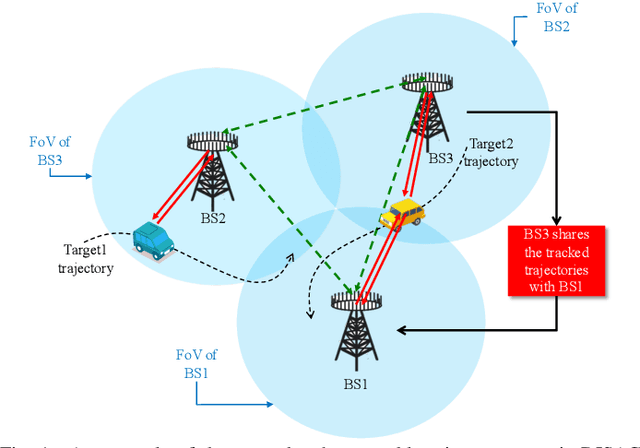
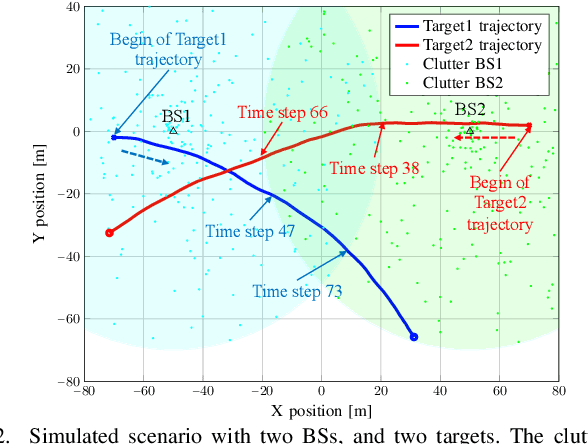
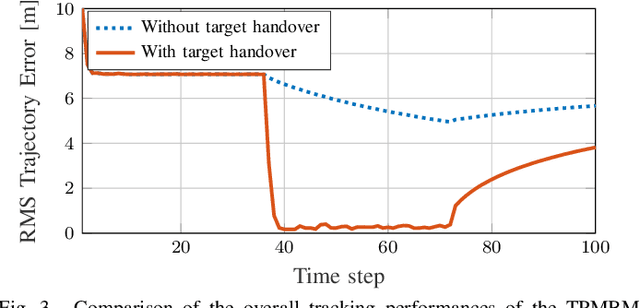
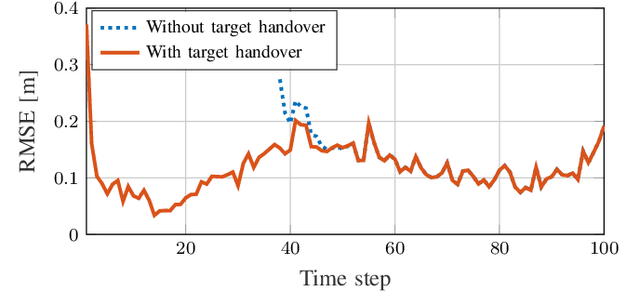
Abstract:The concept of 6G distributed integrated sensing and communications (DISAC) builds upon the functionality of integrated sensing and communications (ISAC) by integrating distributed architectures, significantly enhancing both sensing and communication coverage and performance. In 6G DISAC systems, tracking target trajectories requires base stations (BSs) to hand over their tracked targets to neighboring BSs. Determining what information to share, where, how, and when is critical to effective handover. This paper addresses the target handover challenge in DISAC systems and introduces a method enabling BSs to share essential target trajectory information at appropriate time steps, facilitating seamless handovers to other BSs. The target tracking problem is tackled using the standard trajectory Poisson multi-Bernoulli mixture (TPMBM) filter, enhanced with the proposed handover algorithm. Simulation results confirm the effectiveness of the implemented tracking solution.
Hybrid PHD-PMB Trajectory Smoothing Using Backward Simulation
Jul 20, 2024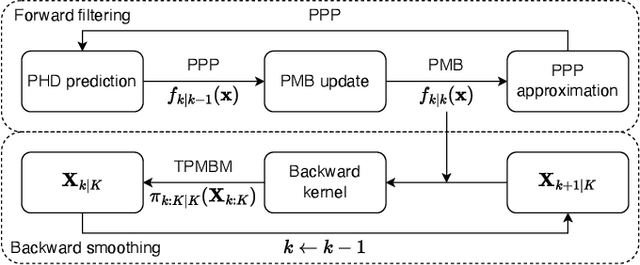
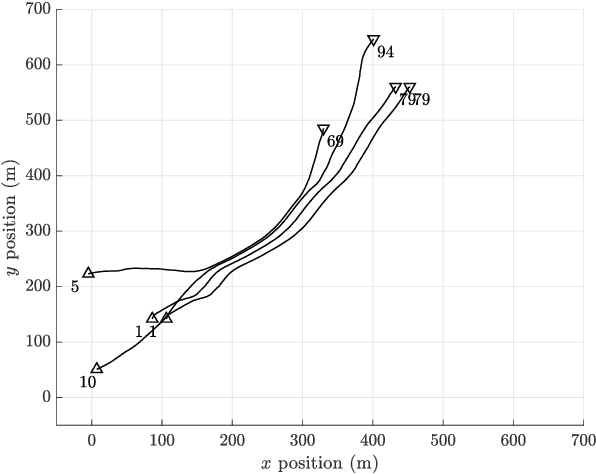
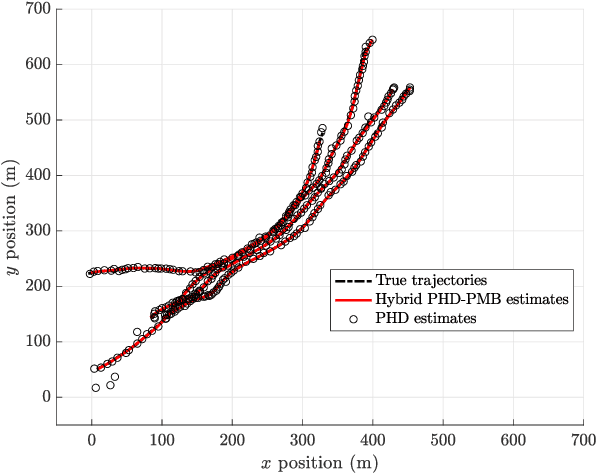

Abstract:The probability hypothesis density (PHD) and Poisson multi-Bernoulli (PMB) filters are two popular set-type multi-object filters. Motivated by the fact that the multi-object filtering density after each update step in the PHD filter is a PMB without approximation, in this paper we present a multi-object smoother involving PHD forward filtering and PMB backward smoothing. This is achieved by first running the PHD filtering recursion in the forward pass and extracting the PMB filtering densities after each update step before the Poisson Point Process approximation, which is inherent in the PHD filter update. Then in the backward pass we apply backward simulation for sets of trajectories to the extracted PMB filtering densities. We call the resulting multi-object smoother hybrid PHD-PMB trajectory smoother. Notably, the hybrid PHD-PMB trajectory smoother can provide smoothed trajectory estimates for the PHD filter without labeling or tagging, which is not possible for existing PHD smoothers. Also, compared to the trajectory PHD filter, which can only estimate alive trajectories, the hybrid PHD-PMB trajectory smoother enables the estimation of the set of all trajectories. Simulation results demonstrate that the hybrid PHD-PMB trajectory smoother outperforms the PHD filter in terms of both state and cardinality estimates, and the trajectory PHD filter in terms of false detections.
Batch SLAM with PMBM Data Association Sampling and Graph-Based Optimization
Jul 16, 2024



Abstract:Simultaneous localization and mapping (SLAM) methods need to both solve the data association (DA) problem and the joint estimation of the sensor trajectory and the map, conditioned on a DA. In this paper, we propose a novel integrated approach to solve both the DA problem and the batch SLAM problem simultaneously, combining random finite set (RFS) theory and the graph-based SLAM approach. A sampling method based on the Poisson multi-Bernoulli mixture (PMBM) density is designed for dealing with the DA uncertainty, and a graph-based SLAM solver is applied for the conditional SLAM problem. In the end, a post-processing approach is applied to merge SLAM results from different iterations. Using synthetic data, it is demonstrated that the proposed SLAM approach achieves performance close to the posterior Cram\'er-Rao bound, and outperforms state-of-the-art RFS-based SLAM filters in high clutter and high process noise scenarios.
 Add to Chrome
Add to Chrome Add to Firefox
Add to Firefox Add to Edge
Add to Edge